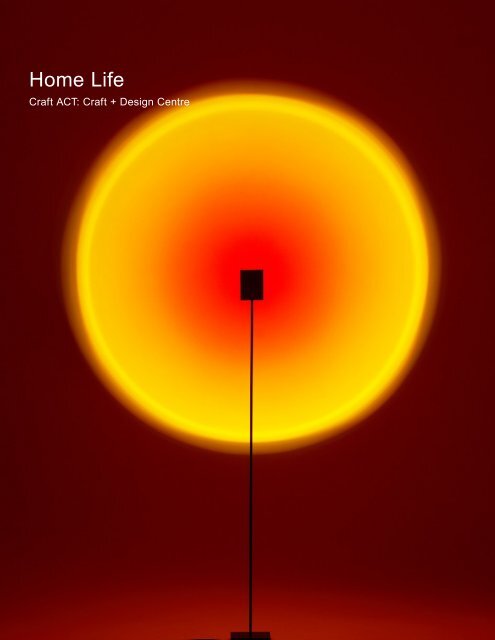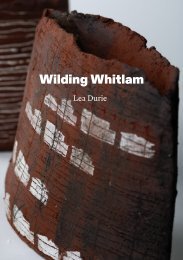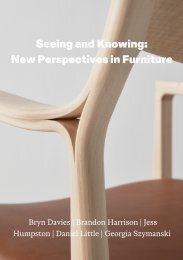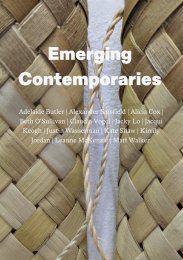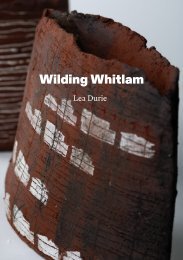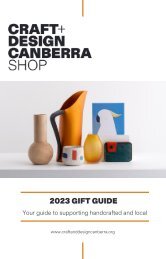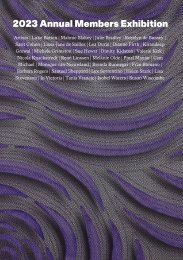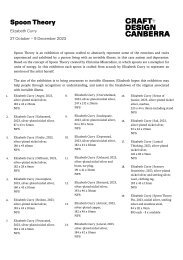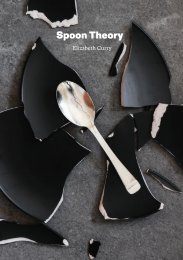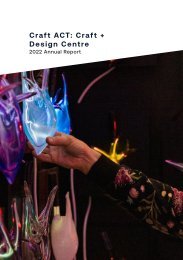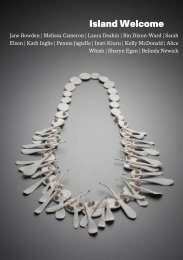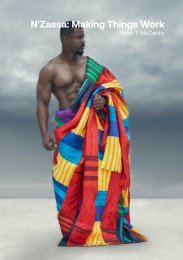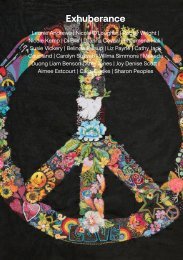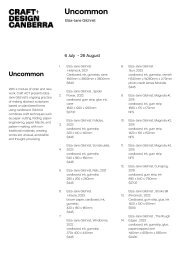Home Life
Create successful ePaper yourself
Turn your PDF publications into a flip-book with our unique Google optimized e-Paper software.
<strong>Home</strong> <strong>Life</strong><br />
Craft ACT: Craft + Design Centre
Craft ACT: Craft + Design Centre is partial supported by the ACT<br />
Government, the Visual Arts and Craft Strategy – an initiative<br />
of the Australian State and Territory Governments, and the<br />
Australia Council for the Arts – the Australian Government’s arts<br />
funding and advisory body.<br />
Craft ACT: Craft + Design Centre acknowledges the<br />
Ngunnawal people as the traditional custodians of the<br />
ACT and surrounding areas. We honour and respect<br />
their ongoing cultural and spiritual connections to this<br />
country and the contribution they make to the life of this<br />
city and this region. We aim to respect cultural heritage,<br />
customs and beliefs of all Indigenous people.<br />
Craft ACT: Craft + Design Centre<br />
Tues–Fri 10am–5pm<br />
Saturdays 12–4pm<br />
Level 1, North Building, 180 London Circuit,<br />
Canberra ACT Australia<br />
+61 2 6262 9333<br />
www.craftact.org.au<br />
Cover image: Portrait of Robert Foster. Photo by Damian McDonald.
<strong>Home</strong> <strong>Life</strong><br />
27 October – 10 December 2022<br />
Falegnameria Pisu for Pretziada | Campeggi | Pedrali | Beeing<br />
| Claudio Larcher | Miniforms | Tubes radiator | Artemide | Halo<br />
Edition | PM Studio | Maria Elena Bompani | Studio Natural | G.T.<br />
Design | Krill Design | Fabita | UniFor | Alcarol | Caimi Brevetti<br />
Spa | Danese Milano | Xilografia |<br />
Exhibition organised by<br />
IMF Foundation, EP studio<br />
In collaboration with<br />
Craft Act: Craft + Design Centre<br />
With the support of<br />
Embassy of Italy Canberra, Italian Cultural Institute Sydney<br />
Sponsored by<br />
Consorzio Prosecco doc – Italian Genio<br />
Curated by<br />
Elisabetta Pisu<br />
Text contribution<br />
Giulia Zappa<br />
Exhibition setup plan<br />
MC studio<br />
Press office<br />
Sign ress<br />
Craft ACT: Craft + Design Centre<br />
27 October - 10 December 2022
Acme21, B-BOX, 2020, Beeing. Photo courtesy of Beeing
Ludovica+Roberto Palomba, Eve, 2018, Tubes Radiatori. Photo Courtesy of Tubes
<strong>Home</strong> <strong>Life</strong><br />
The home – the place of intimacy and daily<br />
habits - is part of a constant metamorphosis<br />
process and, at the same time, it is the<br />
reflection of our evolving lifestyles.<br />
As a result of globalization and its effects on<br />
new nomadism, as well as of a pandemic<br />
that confined billions of people to their own<br />
four walls, the home is now at the center<br />
of renewed attention and innovative design<br />
research.<br />
No longer linked to a functionalist ideal<br />
nor conceived as a status symbol or the<br />
representation of a symbolic universe,<br />
the home is the expression of our desire<br />
for physical and psychological wellbeing.<br />
Furniture and objects designed in the<br />
third decade of the new millennium are<br />
conceived to meet modern needs and<br />
establishing a lasting complicity with users.<br />
Contemporary furniture pieces are highly<br />
modular and adaptable to specific space<br />
configurations. More and more efficient,<br />
they combine multiple functions and change<br />
their appearance to address our needs for<br />
transformability. Smarter than ever, these<br />
pieces contribute to purify air, spark our<br />
imagination, or amuse us with unexpected<br />
functions.<br />
Together with versatility, sustainability is a<br />
fundamental topic of contemporary home<br />
design. In a threatened ecosystem like<br />
ours, the desire for more greenery in indoor<br />
environments becomes stronger by the day.<br />
Through plants and flowers accessories,<br />
multispecies artifacts as well as decoration<br />
evoking nature, design now aims at soothing<br />
our souls in need of a reconnection with<br />
Mother Earth. The choice of ecofriendly<br />
materials is a fundamental element: be<br />
them recycled or natural or both, they are<br />
given organic shapes and are intentionally<br />
designed to have a second life.<br />
Through the selection of a few particular<br />
projects, <strong>Home</strong> <strong>Life</strong> represents the<br />
contemporary focus on comfort, versatility<br />
and environmental awareness and it<br />
highlights the role of the home as epicenter<br />
of a new habitat.
Paolo Cappello, Cigales, 2018, Miniforms. Photo Courtesy of Miniforms
Maddalena Casadei, Accanta, Side Table Collection, 2021, made by Falegnameria Pisu for Pretziada. Photo Courtesy of Pretziada
Accanta, 2021<br />
Side Table Collection<br />
Designer: Maddalena Casadei<br />
Firm: Falegnameria Pisu for Pretziada<br />
This collection of three stool\tables is entirely<br />
made of cork, a sustainable material obtained<br />
from the bark of a type of oak typical of the<br />
Mediterranean area. Based in Sardinia, where<br />
cork trees are part of the natural landscape,<br />
the high craftsmanship firm Pretziada has<br />
rediscovered cork thanks to a young designer<br />
and a local factory. The flared line highlights<br />
the sculpture-like appearance of Accanta,<br />
that can be used to serve many different<br />
purposes.
Anish, 2018<br />
Designer: Emanuele Magini<br />
Firm: Campeggi<br />
A transformable object, intentionally elusive,<br />
Anish’s functions are apparently mysterious<br />
and to be discovered only with use. At a first<br />
glance, it looks like a circular dividing curtain<br />
made of stretch fabric. As one surrenders to<br />
its softness, the semicircular seat becomes<br />
apparent – as one can also find out looking<br />
from behind. Anish invites us to put aside<br />
our most rigid expectations about furniture’s<br />
appearance and functions, and to consider<br />
them as a playful opportunity, a chance for<br />
wonder and surprise.
Image: Emanuele Magini, Anish, 2018, Campeggi. Photo Courtesy of Campeggi
Image: Odo Fioravanti, Babila XL recycled grey, 2020, Pedrali. Photo Courtesy of Pedrali
Babila XL recycled grey, 2020<br />
Designer: Odo Fioravanti<br />
Firm: Pedrali<br />
One of the first products by Italian brand<br />
Pedrali made from recycled polypropylene,<br />
Babila XL recycled grey, is produced 50%<br />
from plastic material post-consumer waste<br />
(as plastic bottles or food packaging) and<br />
50% from plastic material industrial waste.<br />
This combination - resulting from a long process<br />
of industrial research – contributes to<br />
the armchair’s better durability and resistance<br />
to wear and tear. The wide monocoque with<br />
integrated armrests provides high comfort<br />
standards, while the legs are made of FSC®<br />
C114358 certified solid ash wood finished<br />
with water-based paints composed mostly of<br />
plant-derived resins.
B-Box, 2020<br />
Designer: Acme21<br />
Firm: Beeing<br />
B-Box is the first beehive designed for small<br />
urban spaces like a private garden or a terrace.<br />
The bee entrance - a plywood chimney<br />
- is placed over 2 metres above the ground<br />
so that it’s possible to safely approach the<br />
hive without wearing protection. Honey can<br />
be collected through a small box on the lower<br />
part of the hive: B-Box patented system allows<br />
the user to easily extract the “favetti”, the<br />
collection combs where the bees deposit the<br />
honey, without touching the insects. Moreover,<br />
the transparent Plexiglas walls make the<br />
hive suitable for close observation.<br />
Launched via crowdfunding, B-Box has been<br />
purchased by customers in more than 40<br />
countries around the world, both by individuals<br />
and public institutions such as municipalities<br />
and schools.
Image: Acme21, B-BOX, 2020, Beeing. Photo Courtesy of Beeing.
Image: Claudio Larcher, Belt, 2021. Photo Courtesy by Stefania Zanetti.
Belt, 2021<br />
Designer: Claudio Larcher<br />
Belt is a collection of storage furniture that<br />
innovates industrial objects and components<br />
already on the market. Composed of metal<br />
sheets, a belt and four wheels – all elements<br />
easy to be found in DIY stores – Belt is a<br />
versatile and informal piece of furniture that<br />
modernizes the aesthetic of DIY through its<br />
vivid colors.
Cigales, 2018<br />
Designer: Paolo Cappello<br />
Firm: Miniforms<br />
Inspired by the need for more greenery in<br />
home environments, Paolo Cappello has<br />
designed a collection of two-armed étagères<br />
to hold plants and flowerpots. Available both<br />
freestanding and wall mounted, this slender<br />
support can transform a room into an urban<br />
oasis and make daily life more relaxing and<br />
joyful.
Image: Paolo Cappello, Cigales, 2018, Miniforms. Photo Courtesy of Miniforms.
Ludovica+Roberto Palomba, Eve, 2018, Tubes. Photo Courtesy of Tubes Radiatori
Eve, 2018<br />
Designer: Ludovica+Roberto<br />
Palomba<br />
Firm: Tubes radiator<br />
This fan heater’s iconic rounded shape reveals<br />
its double function related to two fundamental<br />
elements of the home environment:<br />
light and heat. In Spring and Autumn, it becomes<br />
a very useful design object, as it can<br />
quickly produce hot air, while in the warmest<br />
months of the year it can be used as a lamp<br />
- a light band at the bottom creates a cosy<br />
atmosphere. Powered by electricity, Eve is a<br />
free-standing piece that can follow its owner<br />
everywhere inside the house.
Flexia, 2020<br />
Designer: Mario Cucinella<br />
Firm: Artemide<br />
Flexia is a suspension lamp combining a<br />
sound-absorbing panel with a transparent<br />
emitting surface; a single object designed<br />
to control both light and sound in an indoor<br />
location. Inspired by papiroflexia, the art of<br />
papyrus-folding, Flexia is reminiscent of the<br />
Japanese art of origami. The lamp’s wings are<br />
flexible and modular so that it can be adjusted<br />
to all room sizes. An example of sustainable<br />
design, a subject dear to architect Mario<br />
Cucinella, Flexia features multiple integrated<br />
and synergic elements: the adaptability to<br />
the characteristics of all environments, the<br />
interpretation of human needs – both physiological<br />
and psychological - and the use of<br />
ecofriendly materials.
Mario Cucinella, Flexia, 2020, Artemide. Photo Courtesy of Artemide
Halo Evo, 2019<br />
Colour: Sunset Red<br />
Designer: Mandalaki Studio<br />
Halo Evo is a light installation that recreates<br />
sunlight inside a home environment giving a<br />
warm and calming sensation in the space, favoring<br />
meditations. The optical device developed<br />
by Milan based Mandalaki Studio guarantees an<br />
accurate visualization as it projects different analogical<br />
hues in a very natural fashion: the result<br />
is an intense and vibrant natural color palette<br />
that creates a sense of infinity. The anodized<br />
aluminium stand supports a flexible head that<br />
allows different projection orientations while a<br />
dimmer can be used to lower the brightness of<br />
the light.<br />
Mandalaki Studio, Halo Evo - Colour sunset red - 2019, Halo Edition. Photo Courtesy of Halo Edition
Hug, 2022<br />
Designer: PM Studio (Barbara<br />
Medeot, Giulia Piovesan)<br />
Hug is a multifunction furniture system designed<br />
to be used in different ways in the home<br />
environment. Its components – a semicircular<br />
top, two curved wooden planks and a series of<br />
sticks – can be easily assembled with a plain<br />
coupling mechanism without additional tools<br />
as nails or glue. According to the selected configuration,<br />
Hug can be a stool, a seat with backrest,<br />
a bookcase or a single piece of furniture<br />
including all the above functions. Made from<br />
beech wood waste, Hug is an example of sustainability<br />
and durability.
PM studio (Barbara Medeot, Giulia Piovesan), Hug, 2022
Itaca, 2016<br />
Designer: Maria Elena Bompani<br />
Increasing mobility is a challenging topic for<br />
designers who need to rethink furniture in<br />
order to make frequent relocations easier and<br />
cheaper. Starting from her personal experience,<br />
Maria Elena Bompani designed a minimal, modular<br />
and flexible furniture set. Made of beech<br />
wood poles, leather belts and fabric elements,<br />
the components can be assembled as needed<br />
to create a daybed, a stool or a room divider<br />
equipped with a built-in desk and storage<br />
spaces. When it’s not needed, the system can<br />
be stored in a suitcase and easily carried to the<br />
next destination.
Maria Elena Bompani, Itaca, 2016
Lucio (Solar Charger Table), 2014<br />
Designer: Studio Natural<br />
One of the first pieces of furniture to feature<br />
solar panels, Lucio combines new energy technologies<br />
with home design. Via a built-in charger<br />
and small solar panels, this coffee table uses<br />
the natural light inside a room and store it to<br />
recharge your laptop and tablet at the end of<br />
the day without any plugs.
Studio Natural, Lucio - solar charger table - 2014. Photo Courtesy by Studio Natural
Moving Forest 0, 2019<br />
Designer: Deanna Comellini<br />
Firm: G.T. Design<br />
Designer Deanna Comellini has transformed an<br />
ancestral object as the rug in an opportunity to<br />
evoke nature and its fascination in one’s home.<br />
The pattern of Moving Forest – made of the<br />
juxtaposition of blue stripes on a green background<br />
– recalls the visual and sensorial perception<br />
of a forest, while the chromatic shades and<br />
the light effects reproduce the vitality of the<br />
flora. Moving Forest aims at creating a visual effect<br />
as well as representing a metaphor; it is an<br />
invitation to surrender to nature and reconnect<br />
with the primordiality of its emotional sphere.<br />
The rug is made of digitally printed high-quality<br />
wool.
Deanna Comellini, Moving Forest 0, 2019, G.T. Design. Photo courtesy of G.T. Design
Ohmie - The Orange Lamp, 2021<br />
Designer: Yack Di Maio and Sofia<br />
Durarte<br />
Firm: Krill Design<br />
Produced by Milan-based startup Krill Design,<br />
Ohmie is the first lamp made from orange peel<br />
waste printed in 3D. The peels are reduced to<br />
dust and mixed with a vegetal biopolymeral<br />
starch that makes the material waterproof. In<br />
order to further reduce waste, the quantity of<br />
material used for each print can be controlled<br />
via the 3D printing procedure. Ohmie’s sinuous<br />
profile evokes the organic forms of nature while<br />
its porous texture recalls that of an orange. The<br />
name derives from the crasis of Ohm (Ω – unit<br />
of electrical resistance) and <strong>Home</strong>. At the end<br />
of its life cycle, the lamp can be biodegraded<br />
together with compost.
Yack di Maio and Sofia Durarte, Ohmie, The Orange Lamp, 2021, Krill Design. Photo courtesy of Krill Design
Ordine, 2019<br />
Designer: Adriano Design<br />
Firm: Fabita<br />
Winner of the the ADI Compasso d’Oro Award<br />
2022, Ordine is designed to optimize food<br />
cooking thanks to its versatility and efficiency.<br />
Two circular induction plates can be positioned<br />
on any flat countertop, even a small one. Once<br />
used, the plates can be hung near the touchscreen<br />
control, leaving the kitchen top free.<br />
Ideal for small spaces, Ordine is the result of<br />
breakthrough innovation.
Adriano Design, Ordine, 2019, Fabita- Photo Courtesy of Fabita
Secretello, 2015<br />
Designer: Michele De Lucchi<br />
Firm: UniFor<br />
Secretello is a hybrid piece of furniture combining<br />
the functions of two personal items: a secretaire<br />
and a display cabinet. Lifting the tilting<br />
crystal and lowering the oak top, Secretello<br />
turns into a workstation. The niche created by<br />
transparent surfaces provides a secret shelter<br />
and enhance concentration. With its doors<br />
closed, Secretello becomes a little contemporary<br />
wunderkammer, an intimate place for<br />
showcasing personal items, collectibles and<br />
ordinary but treasured souvenirs.
Michele De Lucchi, Secretello, 2015, UniFor. ph Mario Carrieri
Stump Stool, 2015<br />
Firm: Alcarol<br />
Stump is an invitation to contemplate nature:<br />
it’s a stool that captures the life of trees valuing<br />
it in a hyper realistic key. Made from discarded<br />
logs from the undergrowth of the Italian Dolomite<br />
mountains (UNESCO heritage site), Stump<br />
is embedded in a resin - recalling the idea of<br />
water and the seed that generated the tree’s life<br />
– that fills all the cracks enveloping mosses and<br />
lichens. The natural wood surface - not covered<br />
by resin on the section planes - features a selective<br />
wood coating with an opaque finishing preserving<br />
the tactile experience of wood.
Photo: Tim Bean Photography<br />
Stump Stool, 2015, alcarol. Photo Courtesy of alcarol
Teleta, 2021<br />
Designer: Alessandro Zambelli<br />
Firm: Caimi Brevetti Spa<br />
A seemingly traditional lamp, Teleta is instead<br />
a multifunctional and innovative device. With<br />
a ceramic diffuser body and a LED, the lamp<br />
includes a clever shell-shaped filter that purifies<br />
air from bacteria. The result of a long research<br />
and development project, the filtering system<br />
uses the heat produced by the LED to push air<br />
upwards where an anodized filter with silver<br />
ions is placed. Thanks to this air-purifying system,<br />
Teleta contributes to the home sanitization<br />
and well-being.
Alessandro Zambelli, Teleta, 2021, Caimi Brevetti spa. Photo courtesy of Caimi Brevetti
Window Garden, 2016<br />
Designer: Big<br />
Firm: Danese Milano<br />
Window Garden is a system of flowerpots suitable<br />
for hydroponic cultures in home environments.<br />
Made of high-pressure porcelain and<br />
held together by a steel wire, the twelve pots<br />
are fitted with a small water reservoir so that no<br />
watering and no saucer is needed. Window Garden<br />
adds a touch of green in your apartment or<br />
office and encourages the user to home grow<br />
vegetables and herbs.
BIG (Bjarke Ingels Group), Window Garden, 2016, Danese Milano. Photo Courtesy of Danese Milano
Xilo Station, 2021<br />
Designer: Matteo Ragni<br />
Firm: Xilografia<br />
Xilo Station is a solution for home environment<br />
where spaces are reduced as it easily turns into<br />
a writing desk. Designed as a wall painting with<br />
customizable graphics, it features a frame and a<br />
folding panel that can be opened when needed,<br />
providing a support surface for computers.<br />
A piece of home décor and a workstation, Xilo<br />
Station has it all.
Matteo Ragni, XiloStation, 2021, XILOGRAFIA
Michele De Lucchi, Secretello, 2015, UniFor. ph Mario Carrieri


